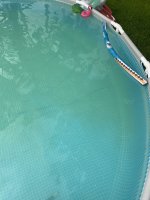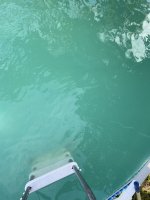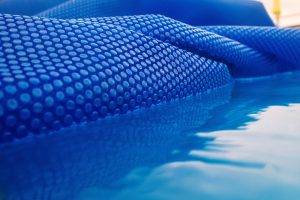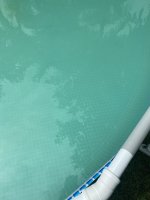Hi Guys! I'm new here 
We are in the very LONG process of building our inground pool so we bought a 16x48 vinyl intex pool for the summer. We put it up at the end of May and things have been great until last week. I will be honest, I have never owned any type of pool before so yes, I am a newbie haha.
On 7/8/21 I arrived home from work to the pool looking teal/green. I could still see the bottom though. I used a brush to scrub the bottom and noticed it was some form of algae. I put one pound of chlorinated shock, cleaned the filter, brushed and allowed the pump to run.
On 7/9/21 early in the morning I brushed the pool walls again and let the pump run until I arrived from work at 4pm. At that time, I cleaned the filter, brushed the walls and vacuumed, poured 64oz of algaecide and let the pump run overnight. I do want to mention the vacuum I have is nothing fancy its one that runs with the garden hose and has a mesh bag.
On 7/10/21 I saw little change except now it looked more like a seafoam green. I poured a jug of liquid chlorine in the pool, brushed the walls and let the pump keep running.
On 7/11/21 we had the water levels tested at the pool store and everything was fine except the high chlorine of course due to the shock and liquid chlorine. We started to think our 1500 pump just wasn't doing the job. So we went out and purchased the larger 2500 pump and its definitely moving faster than the old pump-- it's been running for almost 24 hours now.
Today, 7/12/21 at 7 am, I shut the pump off and cleaned the filter of the new pump (it was dirty). This time I didn't brush the walls-- instead I vacuumed the bottom. I left the pump to run while I am at work.
Honestly, today is day 5 with little to no change and I am at the point of draining and refilling. This problem has seemed to stump just about everybody I have spoken to. I am attaching a couple of photos. Any suggestions????
We are in the very LONG process of building our inground pool so we bought a 16x48 vinyl intex pool for the summer. We put it up at the end of May and things have been great until last week. I will be honest, I have never owned any type of pool before so yes, I am a newbie haha.
On 7/8/21 I arrived home from work to the pool looking teal/green. I could still see the bottom though. I used a brush to scrub the bottom and noticed it was some form of algae. I put one pound of chlorinated shock, cleaned the filter, brushed and allowed the pump to run.
On 7/9/21 early in the morning I brushed the pool walls again and let the pump run until I arrived from work at 4pm. At that time, I cleaned the filter, brushed the walls and vacuumed, poured 64oz of algaecide and let the pump run overnight. I do want to mention the vacuum I have is nothing fancy its one that runs with the garden hose and has a mesh bag.
On 7/10/21 I saw little change except now it looked more like a seafoam green. I poured a jug of liquid chlorine in the pool, brushed the walls and let the pump keep running.
On 7/11/21 we had the water levels tested at the pool store and everything was fine except the high chlorine of course due to the shock and liquid chlorine. We started to think our 1500 pump just wasn't doing the job. So we went out and purchased the larger 2500 pump and its definitely moving faster than the old pump-- it's been running for almost 24 hours now.
Today, 7/12/21 at 7 am, I shut the pump off and cleaned the filter of the new pump (it was dirty). This time I didn't brush the walls-- instead I vacuumed the bottom. I left the pump to run while I am at work.
Honestly, today is day 5 with little to no change and I am at the point of draining and refilling. This problem has seemed to stump just about everybody I have spoken to. I am attaching a couple of photos. Any suggestions????




 You have algae. You need to follow our
You have algae. You need to follow our 

